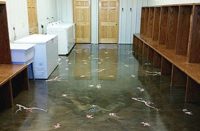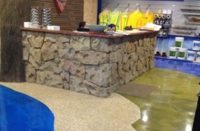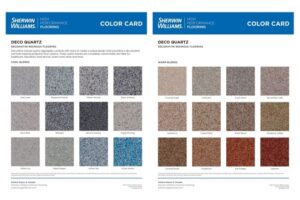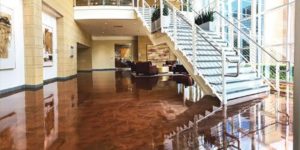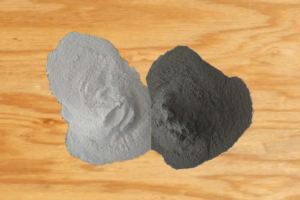Troweled quartz jobs go faster than broadcast jobs because multiple steps aren’t needed to apply the system, says Fernando Franco, part owner and technical director of Bodenkraft, a company in northern New Jersey that specializes in seamless decorative epoxy and concrete flooring systems.
On jobs over 1,500 square feet, he typically has between two and four guys hand-troweling and gauge-raking, with one or two men behind them on power trowels flattening the floor and eliminating trowel marks. “We like to use a power trowel for our final finish,” he says. “It’ll knock off the high spots and flatten things out a little better. You just need to keep it steady like you’re buffing a floor and not push too hard. It isn’t meant to create movement or anything like that. You’re basically just skimming the top and packing it down.”
Because you have more control over a troweled system, it’s easier to achieve multicolor mosaic or terrazzo-like patterns, Franco says. He likes to create patterns using terrazzo or Schluter metal strips before he trowels. “It’s like coloring by numbers,” he says. “You can get some pretty cool effects.” The metal strips also can be bent to create patterns or shapes, glued down and troweled in. It wouldn’t be practical to try to install broadcast systems in the same manner, Franco notes, as you would have to section off an area, broadcast a color and then come back and repeat the procedure another day. “It’d be way too time-consuming,” he says.
With broadcast systems, he adds, it’s almost impossible to control where the different colored sand will end up. “Artistic patterns are more difficult to achieve with broadcast,” Franco says. “You are really limited to what kind of patterns you can make.” However, Franco says, “There’s a simpler learning curve when it comes to broadcast. If a guy can broadcast flakes, he can broadcast quartz.” And although it typically takes him four to five days to install a double-broadcast quartz system, the floor can be installed in a day if a polyaspartic is substituted for the epoxy.
“There are right ways and wrong ways to install these systems,” Franco says. “There’s more to the process than just epoxy and (quartz) sand. Most people don’t understand that it’s a multistep job (that involves prepping, priming and sealing). There are ways to shortcut these systems but they will show up in the long-term performance.”

